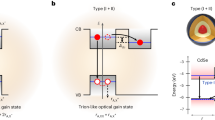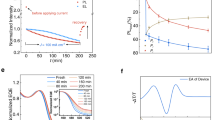Abstract
Blue lasers play a pivotal role in laser-based display, printing, manufacturing, data recording and medical technologies. Colloidal quantum dots (QDs) are solution-grown materials with strong, tunable emission covering the whole visible spectrum, but the development of QD lasers has largely relied on Cd-containing red-emitting QDs, with technologically viable blue QD lasers remaining out of reach. Here we report on the realization of tunable and robust lasing using low-toxicity blue-emitting ZnSe–ZnS core–shell QDs that are compact in size yet still feature suppressed Auger recombination and long optical gain lifetime approaching 1 ns. These characteristics allow us to handle the blue QDs like laser dyes for liquid-state amplified spontaneous emission and lasing. The blue QD laser is operated under quasi-continuous-wave excitation by solid-state nanosecond lasers. A Littrow-configuration cavity enables narrow linewidth (<0.2 nm), wavelength-tunable, coherent and stable laser outputs without circulating the solution. These results indicate the promise of ZnSe–ZnS QDs to fill the ‘blue gap’ of QD lasers and to replace less stable blue laser dyes for a multitude of applications.
This is a preview of subscription content, access via your institution
Access options
Access Nature and 54 other Nature Portfolio journals
Get Nature+, our best-value online-access subscription
$32.99 / 30 days
cancel any time
Subscribe to this journal
Receive 12 print issues and online access
$259.00 per year
only $21.58 per issue
Buy this article
- Purchase on SpringerLink
- Instant access to full article PDF
Prices may be subject to local taxes which are calculated during checkout





Similar content being viewed by others
Data availability
All data are available in the main text or Supplementary Information and can be obtained upon request from K.W. (kwu@dicp.ac.cn). They are also available via figshare at https://doi.org/10.6084/m9.figshare.26763205 (ref. 57). Source data are provided with this paper.
References
Park, Y.-S., Roh, J., Diroll, B. T., Schaller, R. D. & Klimov, V. I. Colloidal quantum dot lasers. Nat. Rev. Mater. 6, 382–401 (2021).
Klimov, V. I. et al. Optical gain and stimulated emission in nanocrystal quantum dots. Science 290, 314–317 (2000).
Fan, F. et al. Continuous-wave lasing in colloidal quantum dot solids enabled by facet-selective epitaxy. Nature 544, 75–79 (2017).
Geiregat, P. et al. Continuous-wave infrared optical gain and amplified spontaneous emission at ultralow threshold by colloidal HgTe quantum dots. Nat. Mater. 17, 35–42 (2018).
Whitworth, G. L., Dalmases, M., Taghipour, N. & Konstantatos, G. Solution-processed PbS quantum dot infrared laser with room-temperature tunable emission in the optical telecommunications window. Nat. Photonics 15, 738–742 (2021).
Ahn, N. et al. Electrically driven amplified spontaneous emission from colloidal quantum dots. Nature 617, 79–85 (2023).
Dang, C. et al. Red, green and blue lasing enabled by single-exciton gain in colloidal quantum dot films. Nat. Nanotechnol. 7, 335–339 (2012).
Tanghe, I. et al. Optical gain and lasing from bulk cadmium sulfide nanocrystals through bandgap renormalization. Nat. Nanotechnol. 18, 1423–1429 (2023).
Schäfer, J. et al. Quantum dot microdrop laser. Nano Lett. 8, 1709–1712 (2008).
Kazes, M., Lewis, D. Y., Ebenstein, Y., Mokari, T. & Banin, U. Lasing from semiconductor quantum rods in a cylindrical microcavity. Adv. Mater. 14, 317–321 (2002).
Kazes, M., Lewis, D. Y. & Banin, U. Method for preparation of semiconductor quantum-rod lasers in a cylindrical microcavity. Adv. Funct. Mater. 14, 957–962 (2004).
Wang, Y. et al. Blue liquid lasers from solution of CdZnS/ZnS ternary alloy quantum dots with quasi-continuous pumping. Adv. Mater. 27, 169–175 (2015).
Duarte, F. J. & Hillman, L. W. Dye Laser Principles: With Applications (Academic Press, 1990).
Schmidt, H. & Hawkins, A. R. The photonic integration of non-solid media using optofluidics. Nat. Photonics 5, 598–604 (2011).
Jelínková, H. Lasers for Medical Applications: Diagnostics, Therapy and Surgery (Elsevier, 2013).
Liu, Y., Li, Y., Gao, K., Zhu, J. & Wu, K. Sub-single-exciton optical gain in lead halide perovskite quantum dots revealed by exciton polarization spectroscopy. J. Am. Chem. Soc. 145, 25864–25873 (2023).
Cooney, R. R., Sewall, S. L., Sagar, D. M. & Kambhampati, P. Gain control in semiconductor quantum dots via state-resolved optical pumping. Phys. Rev. Lett. 102, 127404 (2009).
Wu, K., Park, Y.-S., Lim, J. & Klimov, V. I. Towards zero-threshold optical gain using charged semiconductor quantum dots. Nat. Nanotechnol. 12, 1140–1147 (2017).
Klimov, V. I. Spectral and dynamical properties of multiexcitons in semiconductor nanocrystals. Annu. Rev. Phys. Chem. 58, 635–673 (2007).
Klimov, V. I., Mikhailovsky, A. A., McBranch, D. W., Leatherdale, C. A. & Bawendi, M. G. Quantization of multiparticle Auger rates in semiconductor quantum dots. Science 287, 1011–1013 (2000).
Melnychuk, C. & Guyot-Sionnest, P. Multicarrier dynamics in quantum dots. Chem. Rev. 121, 2325–2372 (2021).
Kambhampati, P., Mack, T. & Jethi, L. Understanding and exploiting the interface of semiconductor nanocrystals for light emissive applications. ACS Photonics 4, 412–423 (2017).
Schäfer, F. P., Schmidt, W. & Volze, J. Organic dye solution laser. Appl. Phys. Lett. 9, 306–309 (1966).
Peterson, O. G., Tuccio, S. A. & Snavely, B. B. CW operation of an organic dye solution laser. Appl. Phys. Lett. 17, 245–247 (1970).
Soffer, B. H. & McFarland, B. B. Continuously tunable, narrow‐band organic dye lasers. Appl. Phys. Lett. 10, 266–267 (2004).
Shank, C. V. Physics of dye lasers. Rev. Mod. Phys. 47, 649–657 (1975).
Kato, K. 3547-Å pumped high-power dye laser in the blue and violet. IEEE J. Quantum Electron. 11, 373–374 (1975).
Shen, J., Wang, W. & Zhang, S. Amplification characteristics of a Coumarin 460-based tunable amplifier. IEEE Photon. J. 12, 1–8 (2020).
Azuma, K., Nakagawa, O., Segawa, Y., Aoyagi, Y. & Namba, S. A tunable picosecond UV dye laser pumped by the third harmonic of a Nd:YAG laser. Jpn J. Appl. Phys. 18, 209 (1979).
Wang, S. et al. Low-threshold amplified spontaneous emission in blue quantum dots enabled by effectively suppressing auger recombination. Adv. Opt. Mater. 9, 2100068 (2021).
Chan, Y. et al. Blue semiconductor nanocrystal laser. Appl. Phys. Lett. 86, 073102 (2005).
Wang, Y., Li, X., Nalla, V., Zeng, H. & Sun, H. Solution-processed low threshold vertical cavity surface emitting lasers from all-inorganic perovskite nanocrystals. Adv. Funct. Mater. 27, 1605088 (2017).
Yakunin, S. et al. Low-threshold amplified spontaneous emission and lasing from colloidal nanocrystals of caesium lead halide perovskites. Nat. Commun. 6, 8056 (2015).
Wang, L. et al. Ultralow-threshold and color-tunable continuous-wave lasing at room-temperature from in situ fabricated perovskite quantum dots. J. Phys. Chem. Lett. 10, 3248–3253 (2019).
Kim, T. et al. Efficient and stable blue quantum dot light-emitting diode. Nature 586, 385–389 (2020).
Gao, M. et al. Bulk-like ZnSe quantum dots enabling efficient ultranarrow blue light-emitting diodes. Nano Lett. 21, 7252–7260 (2021).
Wang, A. et al. Bright, efficient, and color-stable violet ZnSe-based quantum dot light-emitting diodes. Nanoscale 7, 2951–2959 (2015).
Deng, X., Zhang, F., Zhang, Y. & Shen, H. Heavy-metal-free blue-emitting ZnSe(Te) quantum dots: synthesis and light-emitting applications. J. Mater. Chem. C 11, 14495–14514 (2023).
Huang, Z. et al. Broadband tunable optical gain from ecofriendly semiconductor quantum dots with near-half-exciton threshold. Nano Lett. 23, 4032–4038 (2023).
Huang, Z. et al. Deciphering ultrafast carrier dynamics of eco-friendly ZnSeTe-based quantum dots: toward high-quality blue–green emitters. J. Phys. Chem. Lett. 12, 11931–11938 (2021).
Wei, H. et al. Blue lasing from heavy-metal-free colloidal quantum dots. Laser Photonics Rev. 17, 2200557 (2023).
Kozlov, O. V. et al. Sub–single-exciton lasing using charged quantum dots coupled to a distributed feedback cavity. Science 365, 672–675 (2019).
Ji, B., Koley, S., Slobodkin, I., Remennik, S. & Banin, U. ZnSe/ZnS core/shell quantum dots with superior optical properties through thermodynamic shell growth. Nano Lett. 20, 2387–2395 (2020).
García-Santamaría, F. et al. Suppressed Auger recombination in ‘giant’ nanocrystals boosts optical gain performance. Nano Lett. 9, 3482–3488 (2009).
Lim, J., Park, Y.-S. & Klimov, V. I. Optical gain in colloidal quantum dots achieved with direct-current electrical pumping. Nat. Mater. 17, 42–49 (2018).
Cragg, G. E. & Efros, A. L. Suppression of Auger processes in confined structures. Nano Lett. 10, 313–317 (2009).
Long, Z. et al. The strain effects and interfacial defects of large ZnSe/ZnS core/shell nanocrystals. Small 20, 2306602 (2024).
Bisschop, S., Geiregat, P., Aubert, T. & Hens, Z. The impact of core/shell sizes on the optical gain characteristics of CdSe/CdS quantum dots. ACS Nano 12, 9011–9021 (2018).
Rinke, M. & Güsten, H. Optische Aufheller als Laserfarbstoffe. Ber. Bunsenges. Phys. Chem. 90, 439–444 (1986).
Htoon, H., Hollingworth, J., Malko, A., Dickerson, R. & Klimov, V. Light amplification in semiconductor nanocrystals: quantum rods versus quantum dots. Appl. Phys. Lett. 82, 4776 (2003).
Ahn, N. et al. Optically excited lasing in a cavity-based, high-current-density quantum dot electroluminescent device. Adv. Mater. 35, 2206613 (2023).
Casperson, L. W. Threshold characteristics of mirrorless lasers. J. Appl. Phys. 48, 256–262 (1977).
Jones, M., Nedeljkovic, J., Ellingson, R. J., Nozik, A. J. & Rumbles, G. Photoenhancement of luminescence in colloidal CdSe quantum dot solutions. J. Phys. Chem. B 107, 11346–11352 (2003).
Hines, M. A. & Guyot-Sionnest, P. Bright UV-blue luminescent colloidal ZnSe nanocrystals. J. Phys. Chem. B 102, 3655–3657 (1998).
Lin, S. et al. Surface and intrinsic contributions to extinction properties of ZnSe quantum dots. Nano Res. 13, 824–831 (2020).
Jang, E.-P. et al. Synthesis of alloyed ZnSeTe quantum dots as bright, color-pure blue emitters. ACS Appl. Mater. Interfaces 11, 46062–46069 (2019).
Wu, K. Figures for “Blue laser using low-toxicity quantum dots in liquids”. figshare https://doi.org/10.6084/m9.figshare.26763205 (2024).
Acknowledgements
K.W. acknowledges financial support from the Chinese Academy of Sciences (YSBR-007; XDB0970303), the Dalian Institute of Chemical Physics (DICP I202246) and the New Cornerstone Science Foundation through the XPLORER PRIZE.
Author information
Authors and Affiliations
Contributions
K.W. and X. Lin conceived the idea of this study. K.W. supervised and coordinated the project. X. Li and J.D. conducted initial studies on liquid QD lasing that inspired that current project. X. Lin synthesized the QDs and measured their spectroscopy and ASE. X. Lin, Y.Y. and X. Li measured the liquid laser with help from C.X., X. Luo and D.Z. Y.L. and J.D. synthesized the large-core QDs for control experiments and the QDs for film ASE measurements. Z.W. measured the PLE of the QDs. K.W. and X. Lin wrote the paper with inputs from all authors.
Corresponding authors
Ethics declarations
Competing interests
The authors declare no competing interests.
Peer review
Peer review information
Nature Nanotechnology thanks Pieter Geiregat and Patanjali Kambhampati for their contribution to the peer review of this work.
Additional information
Publisher’s note Springer Nature remains neutral with regard to jurisdictional claims in published maps and institutional affiliations.
Supplementary information
Supplementary Information
Supplementary Notes 1–3, Figs. 1–16 and references.
Source data
Source Data Fig. 1
Fig. 1 source data in spreadsheet.
Source Data Fig. 2
Fig. 2 source data in spreadsheet.
Source Data Fig. 3
Fig. 3 source data in spreadsheet.
Source Data Fig. 4
Fig. 4 source data in spreadsheet.
Source Data Fig. 5
Fig. 5 source data in spreadsheet.
Rights and permissions
Springer Nature or its licensor (e.g. a society or other partner) holds exclusive rights to this article under a publishing agreement with the author(s) or other rightsholder(s); author self-archiving of the accepted manuscript version of this article is solely governed by the terms of such publishing agreement and applicable law.
About this article
Cite this article
Lin, X., Yang, Y., Li, X. et al. Blue lasers using low-toxicity colloidal quantum dots. Nat. Nanotechnol. 20, 229–236 (2025). https://doi.org/10.1038/s41565-024-01812-0
Received:
Accepted:
Published:
Issue date:
DOI: https://doi.org/10.1038/s41565-024-01812-0
This article is cited by
-
Quantum dots are beginning to lase in the blue
Nature Nanotechnology (2025)



